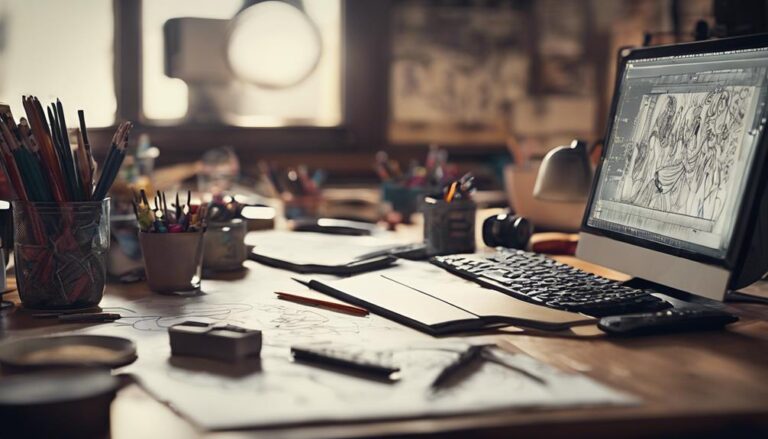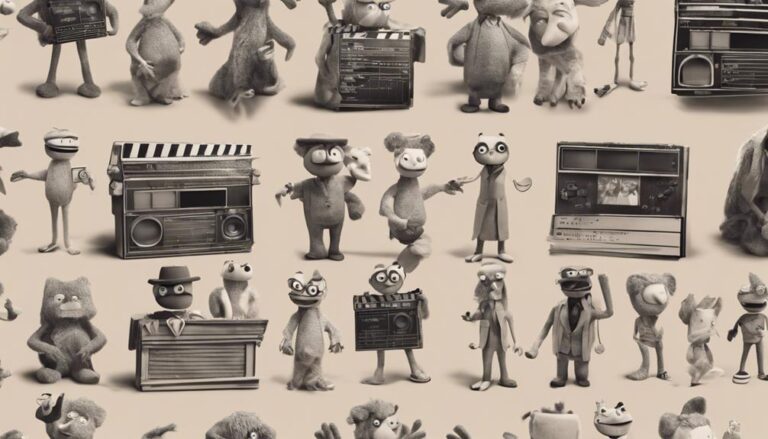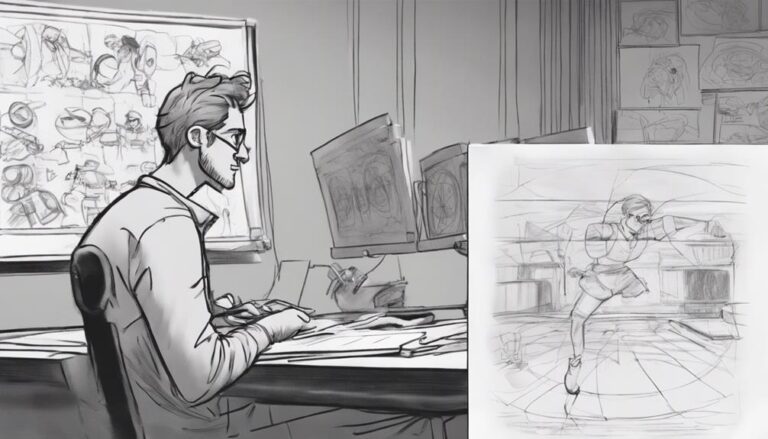What Makes CGI Visual Effects So Convincing?
As you watch a movie or play a game with stunning CGI visual effects, you're likely unaware of the intricate techniques used to deceive your brain. It's not just about creating photorealistic images; it's about manipulating your perception and attention. The subtle cues, the carefully crafted imperfections, and the meticulous study of real-world references all work together to create an illusion that's almost indistinguishable from reality. But what specific strategies do artists employ to achieve this level of realism, and how do they balance detail with subtlety to create an immersive experience?
Key Takeaways
- Masterful manipulation of visual cues directs the audience's attention and fills in gaps in perception, creating a convincing illusion.
- Realistic environments are crafted by balancing lighting effects, shadow nuances, and color temperature to evoke a specific mood or atmosphere.
- Authentic character animation and behavior are achieved through subtle motion curve design, nuanced gestures, and realistic weight shifts and eye movements.
- Imperfection design introduces deliberate flaws and variations to create a sense of realism, making environments and characters more believable.
- Understanding human perception and attention enables CGI artists to exploit the brain's tendency to interpret incomplete information, making visual effects more convincing.
The Psychology of Visual Perception
When you gaze at a computer-generated image (CGI), your brain instinctively searches for cues to distinguish it from reality, relying on the complex interplay between visual perception, attention, and past experiences.
This intricate dance is rooted in brain trickery, where your mind fills in gaps and makes assumptions based on what it knows about the world.
To create convincing CGI, visual effects artists must masterfully manipulate these visual cues, exploiting the brain's tendency to interpret incomplete information.
Understanding Human Attention Span
As you create CGI visual effects, you need to ponder how your audience's attention span works – where their eyes focus first, what details they prioritize, and how they process visual information in a hierarchical manner.
You'll want to direct their gaze to key elements by strategically placing visual cues, and make sure vital details aren't lost in the visual noise.
Where Eyes Focus First
In the blink of an eye, your gaze darts towards the most striking visual elements, as your brain instinctively prioritizes processing the most attention-grabbing information.
This automatic response is rooted in your eye movement patterns, which are guided by visual cues that signal importance or relevance. When scanning a scene, your eyes are drawn to areas with high contrast, vibrant colors, or sharp edges – all of which trigger a neural response that says, 'Pay attention to this!'
These visual cues serve as beacons, directing your attention to the most critical elements in the visual hierarchy.
Your brain then allocates processing power accordingly, devoting more resources to analyze and understand the highlighted information. This selective attention enables you to efficiently filter out distractions and focus on the essence of the scene.
Attention to Key Details
Your attention is drawn to key details because your brain is wired to prioritize information that stands out, and CGI artists can use this to their advantage by creating visual effects that strategically highlight critical elements, making them virtually impossible to ignore.
This is especially true when it comes to capturing minute nuances in human behavior, such as micro expressions that reveal a character's true emotions. By focusing on these subtle details, CGI artists can create a sense of realism that's hard to shake.
Facial expressions: Subtle tweaks to a character's facial muscles can convey a range of emotions, from sadness to anger.
Eye movement: Realistic eye movement can make a character feel more alive and engaging.
Body language: A character's posture, gait, and other physical cues can reveal their personality and intentions.
Environmental details: Incorporating small details like dust, dirt, or wear and tear on objects can make a scene feel more immersive and realistic.
Visual Hierarchy Matters
When crafting CGI visual effects, you must consider the visual hierarchy of a scene, strategically guiding the viewer's attention to specific elements within a limited attention span of about 8-12 seconds.
This means prioritizing visual balance, ensuring that the most critical elements stand out while secondary details recede into the background.
Composition rules, such as the rule of thirds, leading lines, and framing, help you create a visual flow that directs the viewer's gaze.
Crafting Realistic Lighting Effects
You manipulate lighting effects to achieve photorealism by mastering the subtleties of real-world illumination, from the soft warmth of a sunrise to the harsh glare of a city street at noon.
To create a believable scene, you must carefully balance lighting ratios, taking into account the intensity and color of each light source. This involves subtle adjustments to avoid harsh contrasts and guarantee a natural-looking shift between light and dark areas.
Some key considerations for crafting realistic lighting effects include:
Shadow nuances: Soft, gradient-like shadows can add depth and volume to objects, while sharp, defined shadows can create a sense of crispness and clarity.
Lighting ratios: Balancing the intensity of different light sources to create a natural-looking scene.
Color temperature: Using warm or cool tones to evoke a specific mood or atmosphere.
Ambient Occlusion: Simulating the way light scatters and absorbs in real-world environments to add depth and realism.
The Power of Subtle Animation
Subtle animation techniques breathe life into CGI visuals by introducing minute, yet impactful, movements that convincingly mimic the intricacies of the natural world.
When you watch a CGI character, you'll notice subtle twitches, blinks, and posture adjustments that make them feel more human.
These subtle movements are achieved through meticulous motion curve design, where animators carefully craft the acceleration, deceleration, and ease-in/ease-out of each action.
By fine-tuning these curves, you can create a sense of weight, fluidity, and realism that draws the viewer in.
As you explore further, you'll discover that subtle animation is also key to character nuance.
A well-animated character can convey emotions and intentions through the slightest of gestures, making them feel more relatable and authentic.
For instance, a character's hesitant finger tap or a slight shoulder roll can speak volumes about their personality and motivations.
Leveraging Real-World References
As you set out to create convincing CGI visual effects, you'll find that leveraging real-world references is key to achieving authenticity.
You'll want to observe nature's intricate details, from the way light filters through leaves to the subtle patterns on a rocky cliff face.
Observing Nature's Details
By venturing outdoors and attentively observing the intricate patterns, textures, and behaviors of the natural world, CGI artists can gather invaluable reference points to inform and enrich their digital creations. This observation of nature's details is vital in creating convincing visual effects.
As you explore the outdoors, pay attention to the subtleties that make the natural world so enthralling. Note the way light filters through leaves, casting intricate shadows on the forest floor. Observe how atmospheric nuances affect the color palette of a sunset, shifting from warm oranges to cool blues. These nuances can be replicated in CGI to create a more immersive experience.
Some key aspects to focus on include:
Botany observation: Study the structure and texture of plants, from the delicate patterns on a flower petal to the gnarled branches of an ancient tree.
Atmospheric nuances: Capture the ever-changing moods of the sky, from the soft haze of morning to the dramatic storms of afternoon.
Water behavior: Analyze the flow, ripples, and reflections of water in various contexts, such as rivers, oceans, and puddles.
Lighting effects: Observe how light interacts with different materials, casting shadows, highlights, and ambient Occlusion.
Studying Human Behavior
To craft believable character animations and interactions, you'll want to immerse yourself in the intricacies of human behavior, carefully observing how people move, react, and engage with their surroundings.
This involves more than just mimicking physical actions; it's about capturing the subtleties of human emotions and social cues. Facial cues, for instance, can convey a wealth of information, from subtle twitches to overt expressions of joy or fear.
By studying how people's faces respond to different situations, you can create more nuanced and realistic character reactions.
Body language is another pivotal aspect of human behavior that can make or break the believability of your CGI characters.
From posture and gestures to subtle weight shifts and eye movements, every detail counts.
By observing how people interact with each other and their environment, you can create characters that feel more authentic and relatable.
Analyzing Real-World Textures
Meticulously studying real-world textures is key to crafting CGI environments and characters that are visually stunning and undeniably realistic, allowing you to infuse your digital creations with the subtleties and complexities of the natural world.
By analyzing real-world textures, you'll gain a deeper understanding of how light interacts with different materials, creating a more authentic look in your CGI work.
To achieve this, you'll need to capture high-resolution photographs of textures in various lighting conditions.
Use material capture techniques to scan and digitize real-world materials.
Create detailed surface maps to accurately represent the intricate details of real-world textures.
Study the way textures age, decay, and respond to environmental factors, such as weathering or erosion.
The Art of Imperfection Design
In the domain of CGI visual effects, imperfection design emerges as a deliberate creative choice, allowing artists to skillfully craft nuanced, lifelike environments and characters that subtly deviate from perfection.
When you're tasked with creating realistic CGI elements, you'll often focus on incorporating design nuances that make them feel more authentic. This is where imperfect patterns come into play. By introducing subtle irregularities, such as uneven textures, asymmetrical shapes, or minor defects, you can create a sense of realism that's hard to achieve with perfect, uniform designs.
As you work on your CGI project, remember that imperfection is key to creating believable environments and characters. You might add slight variations in color, texture, or shape to create a sense of wear and tear, or introduce minor flaws to give your design a more organic feel.
Manipulating Depth and Scale
By masterfully manipulating depth and scale, CGI artists can craft visually stunning environments that transport audiences to new worlds, where towering structures stretch towards the horizon and intricate details unfold with precision.
You're likely familiar with the concept of depth cues, which are visual hints that help our brains perceive distance and dimensionality. CGI artists use these cues to create a sense of depth, making it easier for you to become fully immersed in the scene.
CGI artists manipulate depth and scale in the following ways:
Atmospheric perspective: Artists use color, contrast, and clarity to create a sense of distance, making objects fade into the background.
Scaling objects: By adjusting the size of objects relative to each other, artists can create a sense of depth and distance.
Layering elements: Artists use layering to create a sense of depth, with foreground, mid-ground, and background elements working together to create a cohesive scene.
Using scale models: Physical scale models can be used as reference points to verify that digital environments are proportional and realistic.
Frequently Asked Questions
How Do Visual Effects Artists Handle Copyrighted Material in Their Work?
"When incorporating copyrighted materials, you navigate complex clearance challenges, ensuring compliance with copyright laws to avoid legal issues, and obtain necessary permissions to use protected assets, adding authenticity to your visual effects."
Can CGI Be Used to Create Realistic Visual Effects for Live Theater?
You can leverage CGI to create breathtaking stage magic in live theater, heightening theater immersion by projecting realistic environments, characters, or effects onto sets, seamlessly integrating digital and physical elements to captivate your audience.
What Software Do Most Visual Effects Artists Use for CGI Work?
You'll find that most visual effects artists rely on industry-standard software like Autodesk Maya, Blender, and Nuke for CGI work, following software trends that emphasize flexibility, precision, and collaboration in their digital artistry.
How Do Visual Effects Artists Ensure Consistency Across Multiple Shots?
You certify consistency across multiple shots by establishing shot continuity, maintaining visual cohesion through consistent lighting, camera angles, and CGI elements, and utilizing reference guides to guarantee a seamless visual narrative.
Can CGI Visual Effects Be Used in Video Games and Virtual Reality?
You can seamlessly integrate CGI visual effects into video games, leveraging game interactivity to create immersive experiences, and virtual reality, where virtual realism is vital, to craft breathtakingly realistic environments that transport players to new worlds.
Conclusion
As you plunge into the world of CGI visual effects, remember that the key to convincing illusions lies in understanding the intricacies of human perception.
By masterfully guiding attention, crafting realistic environments, and introducing imperfections, artists create a sense of authenticity.
By manipulating depth, scale, and subtle animation, the boundaries between reality and fantasy blur.
The result: a visual experience that not only dazzles but also deceives, leaving you utterly convinced of the impossible.







